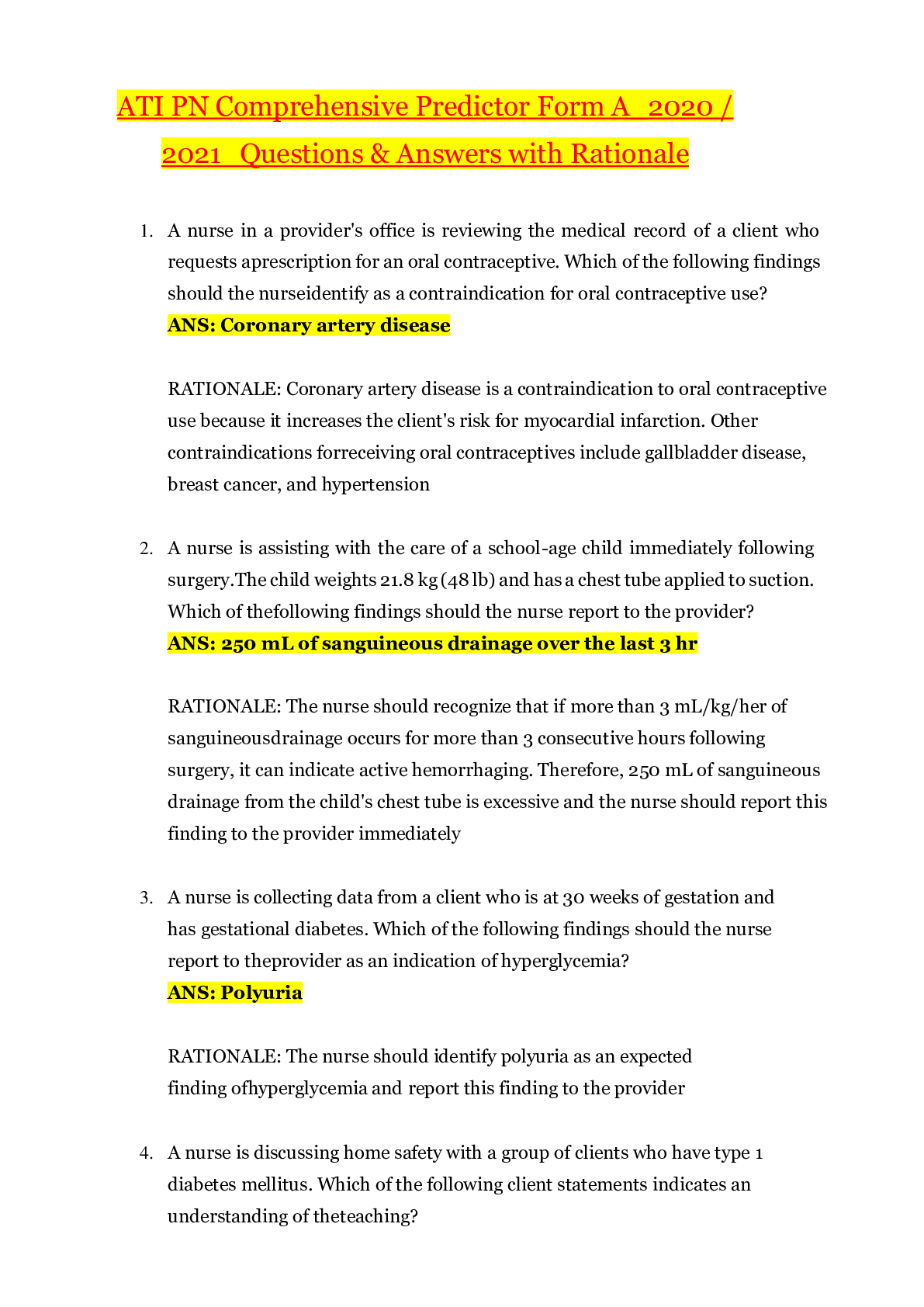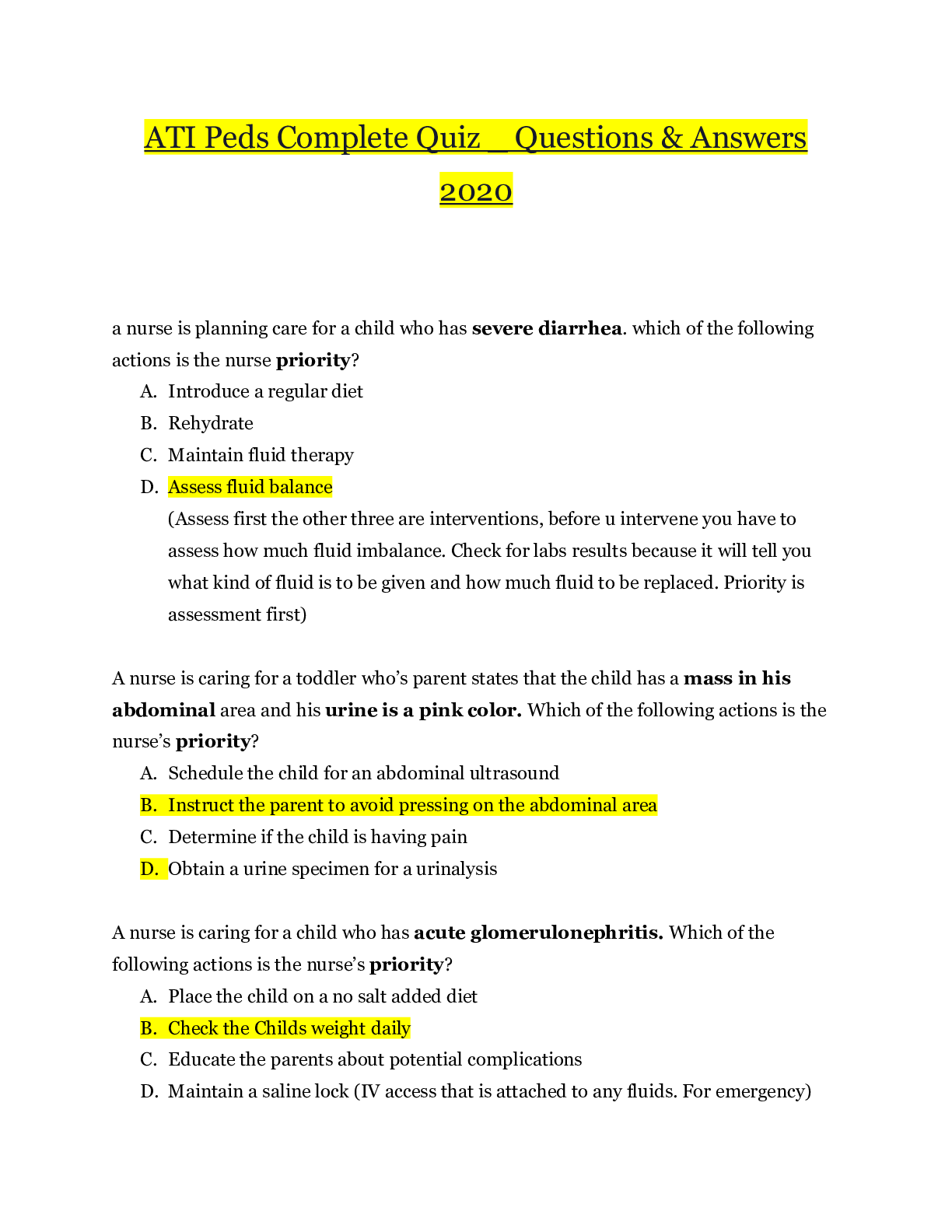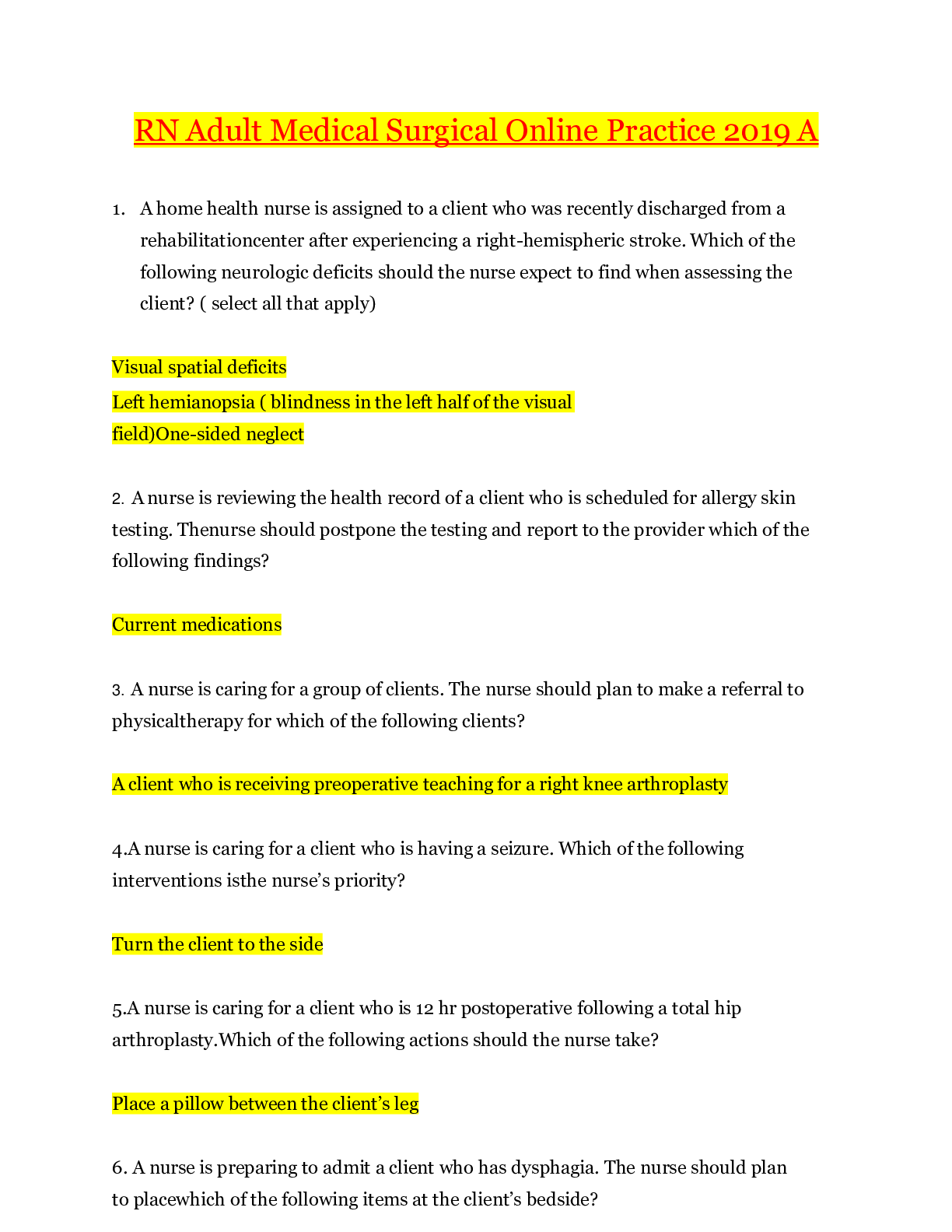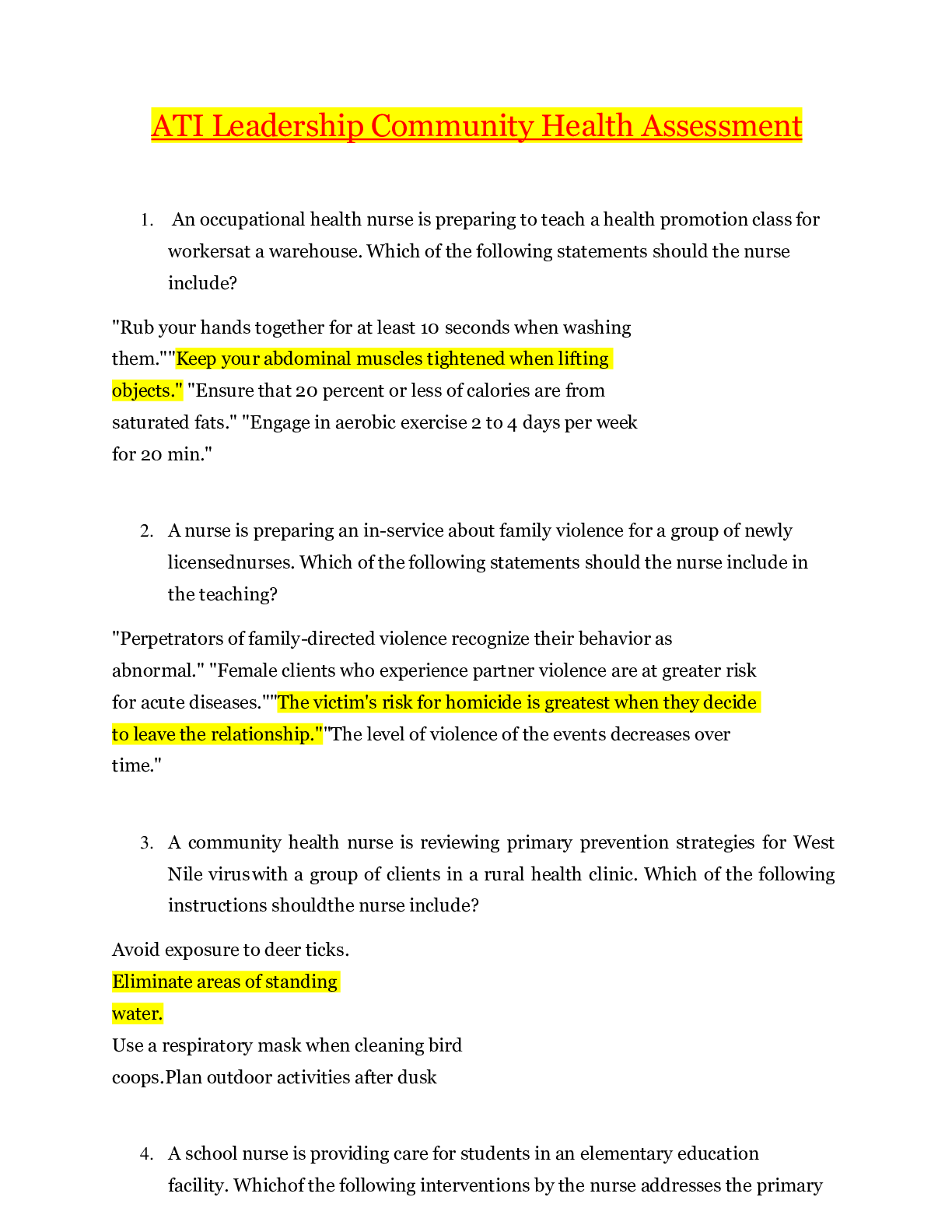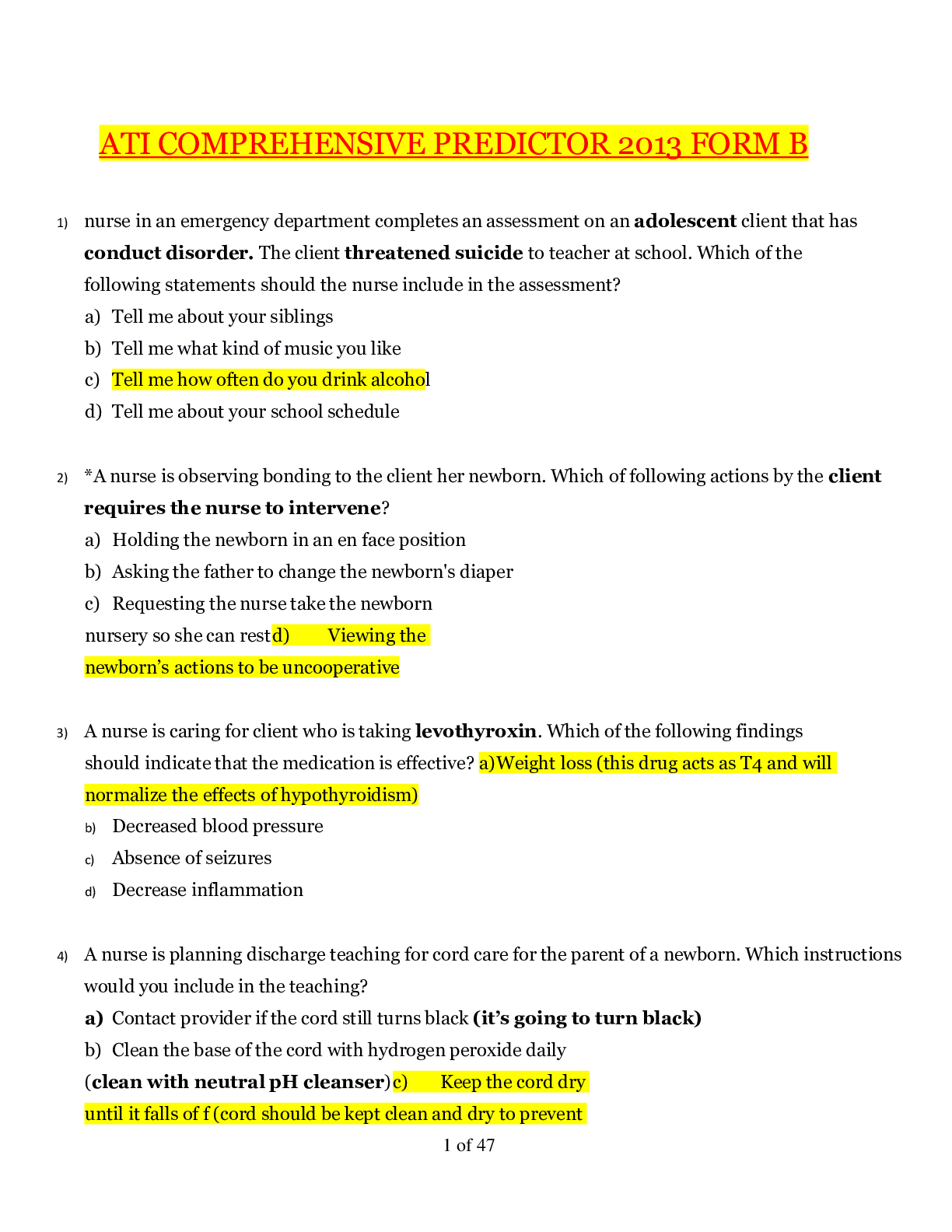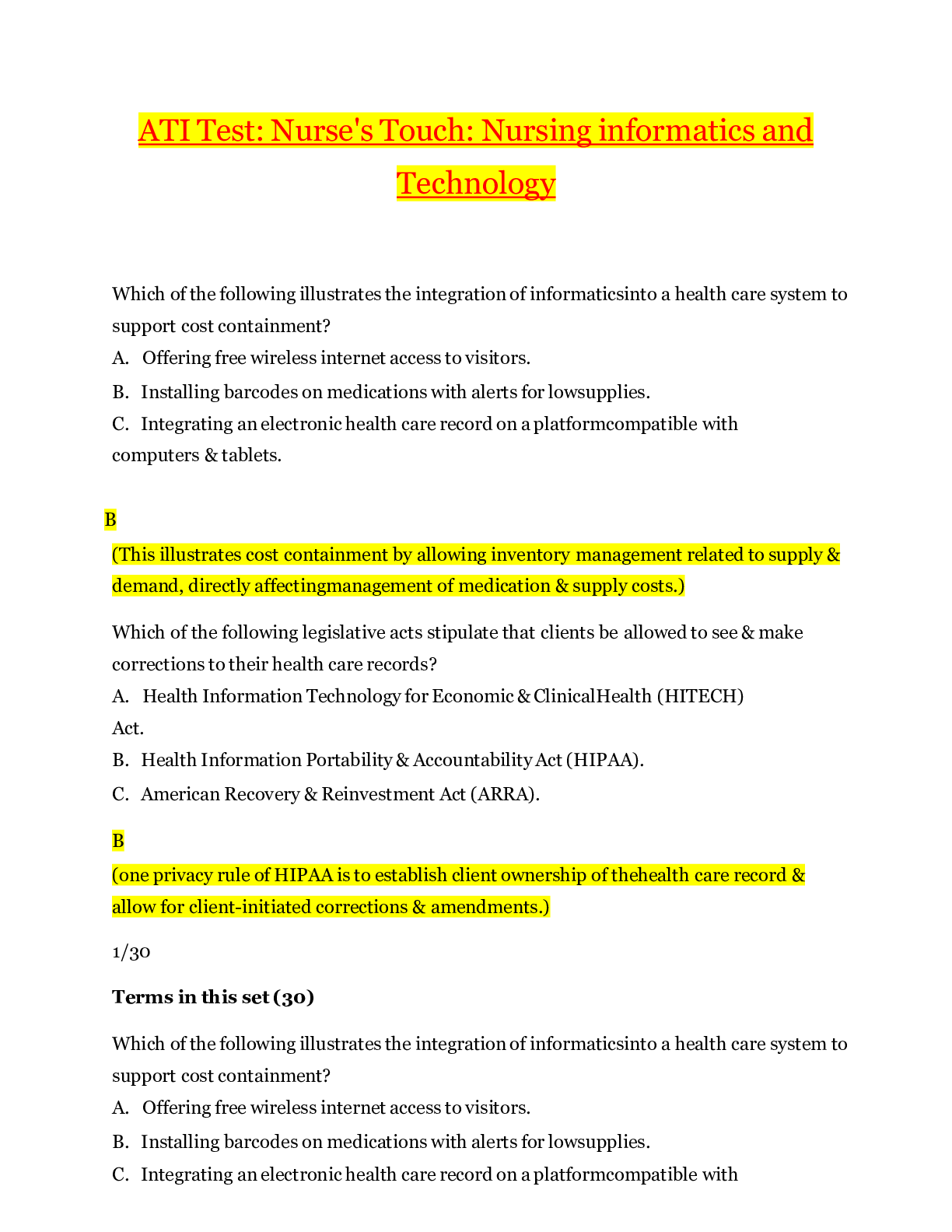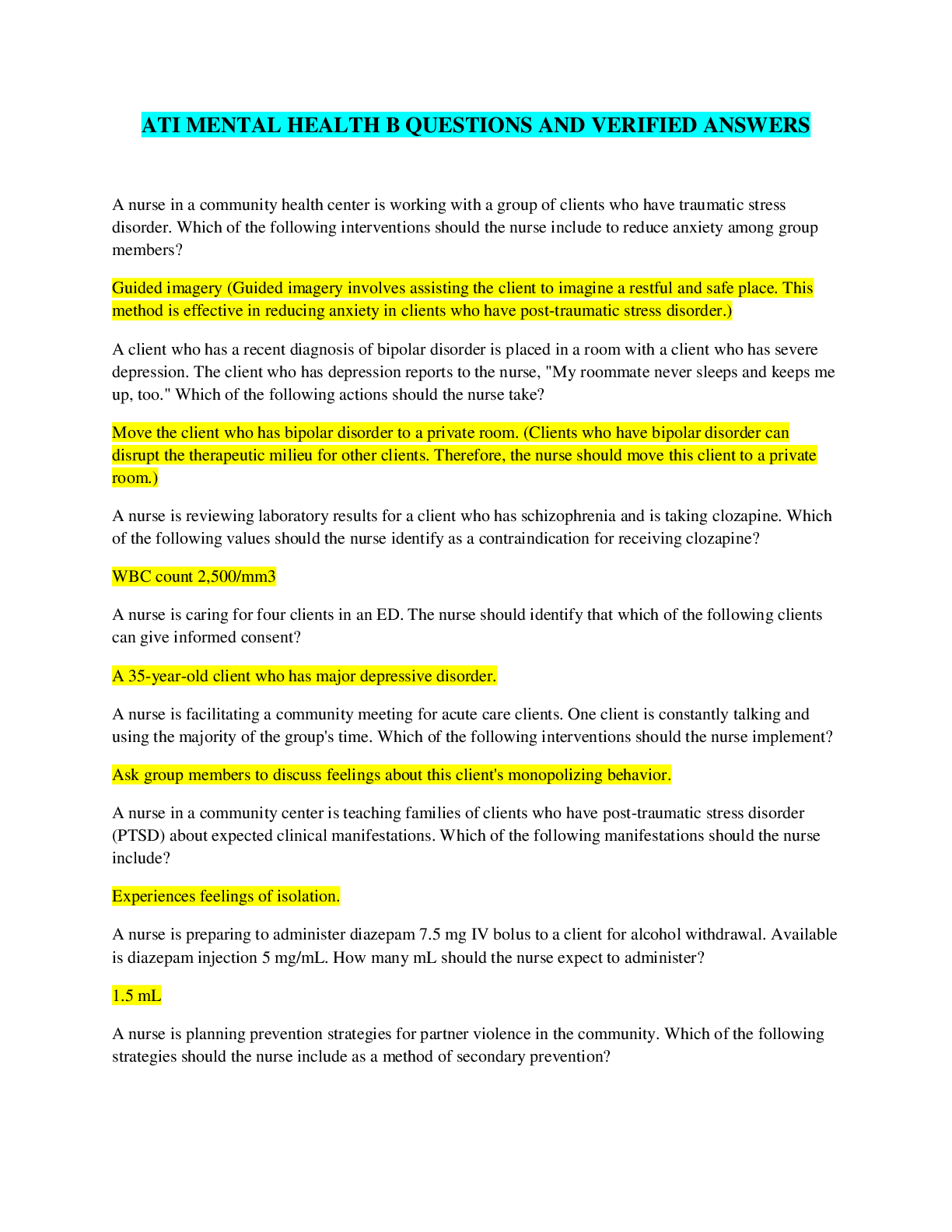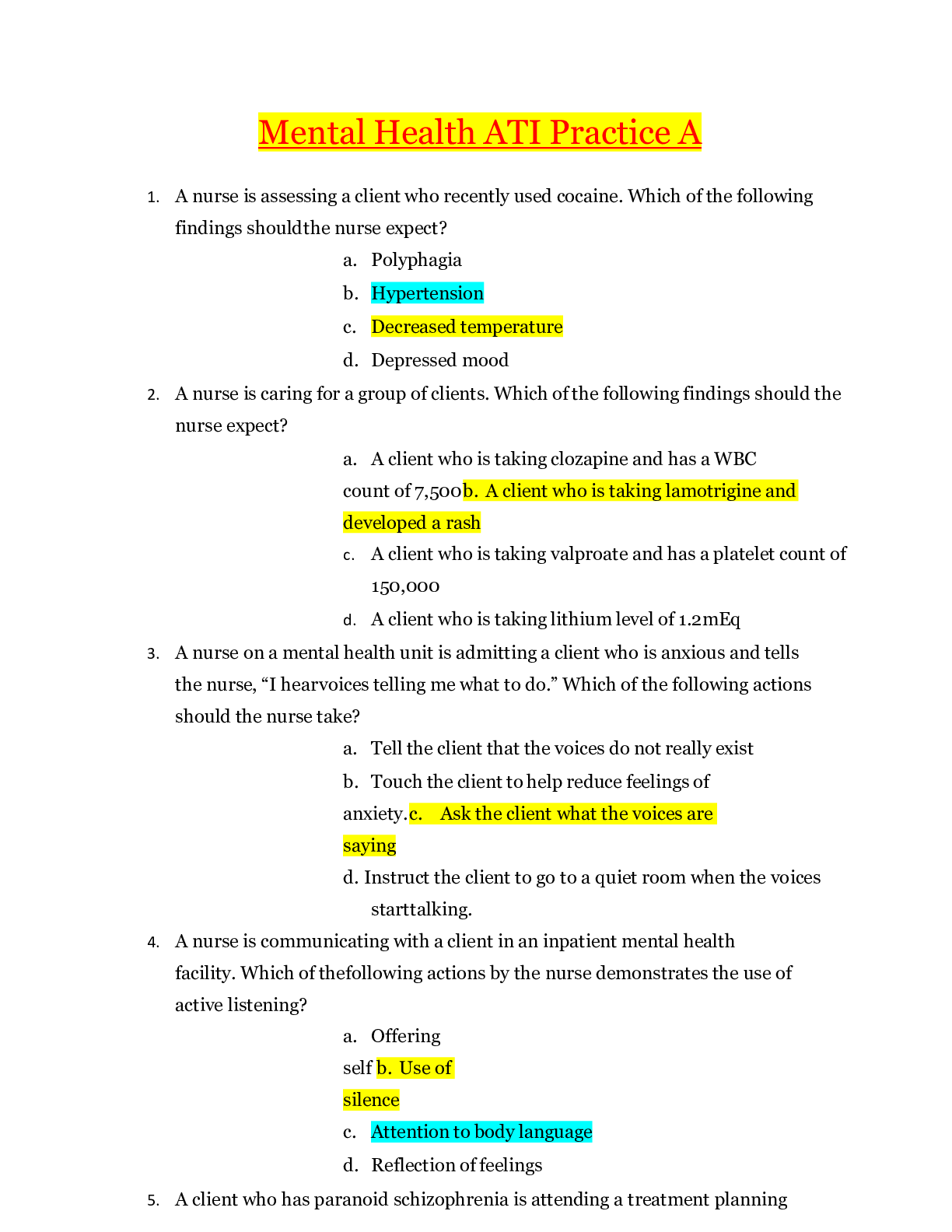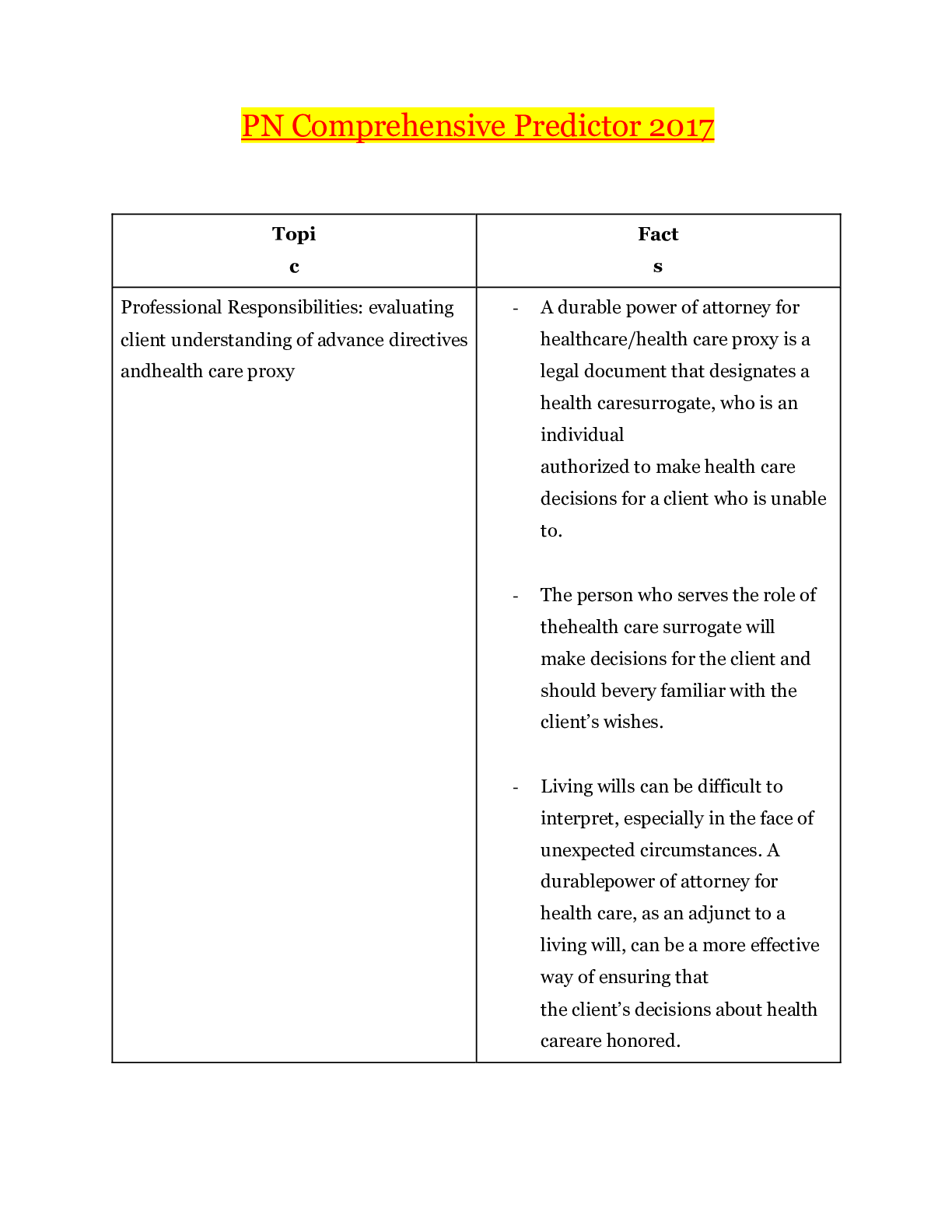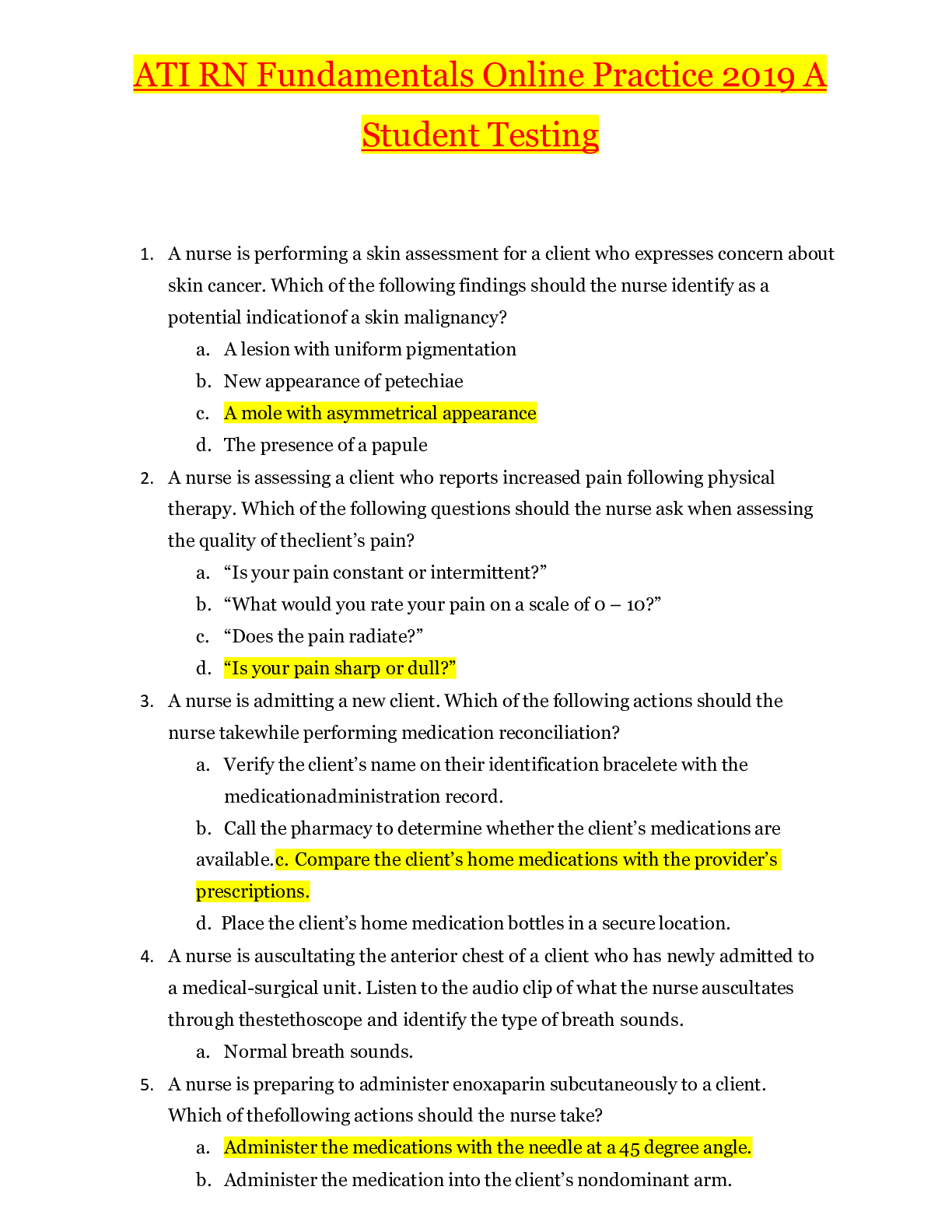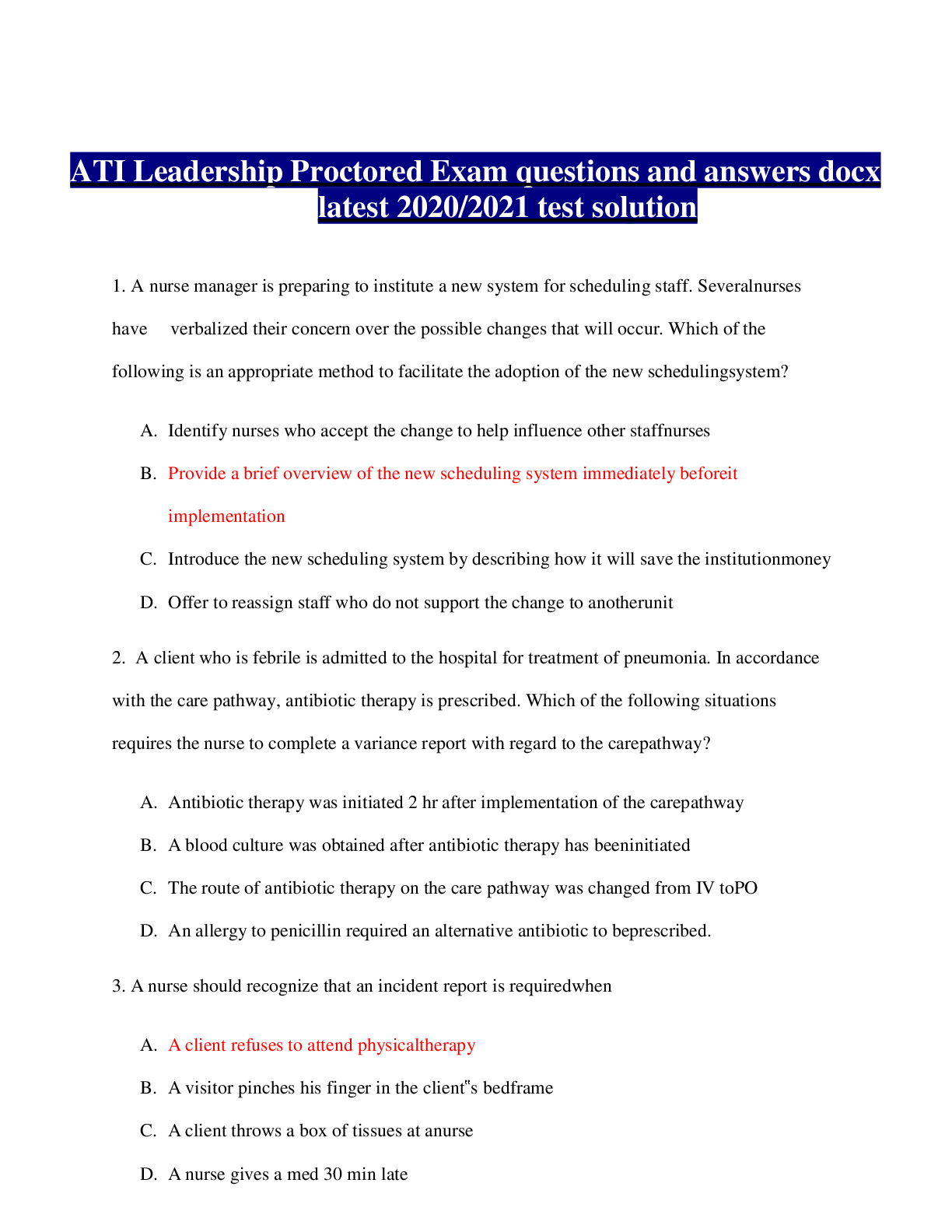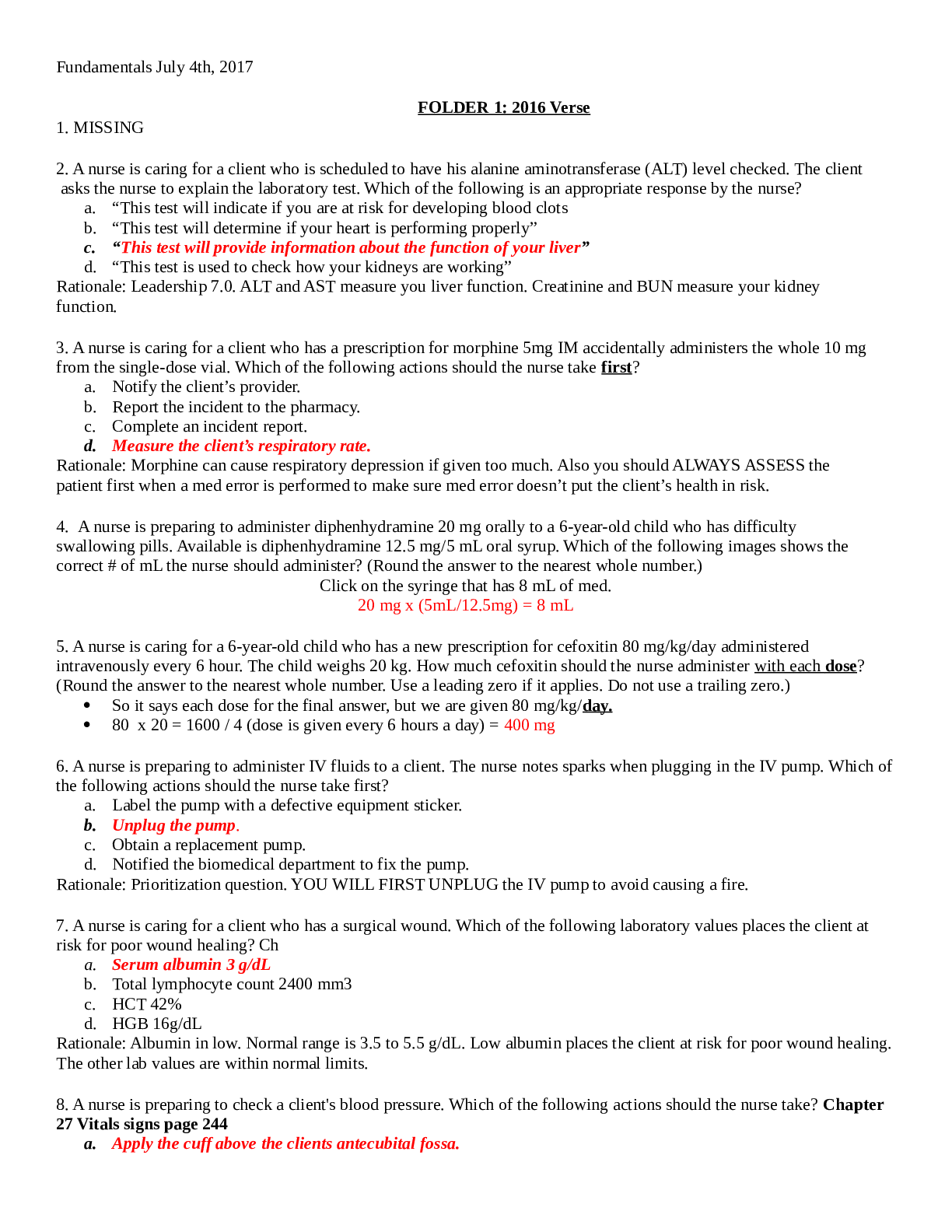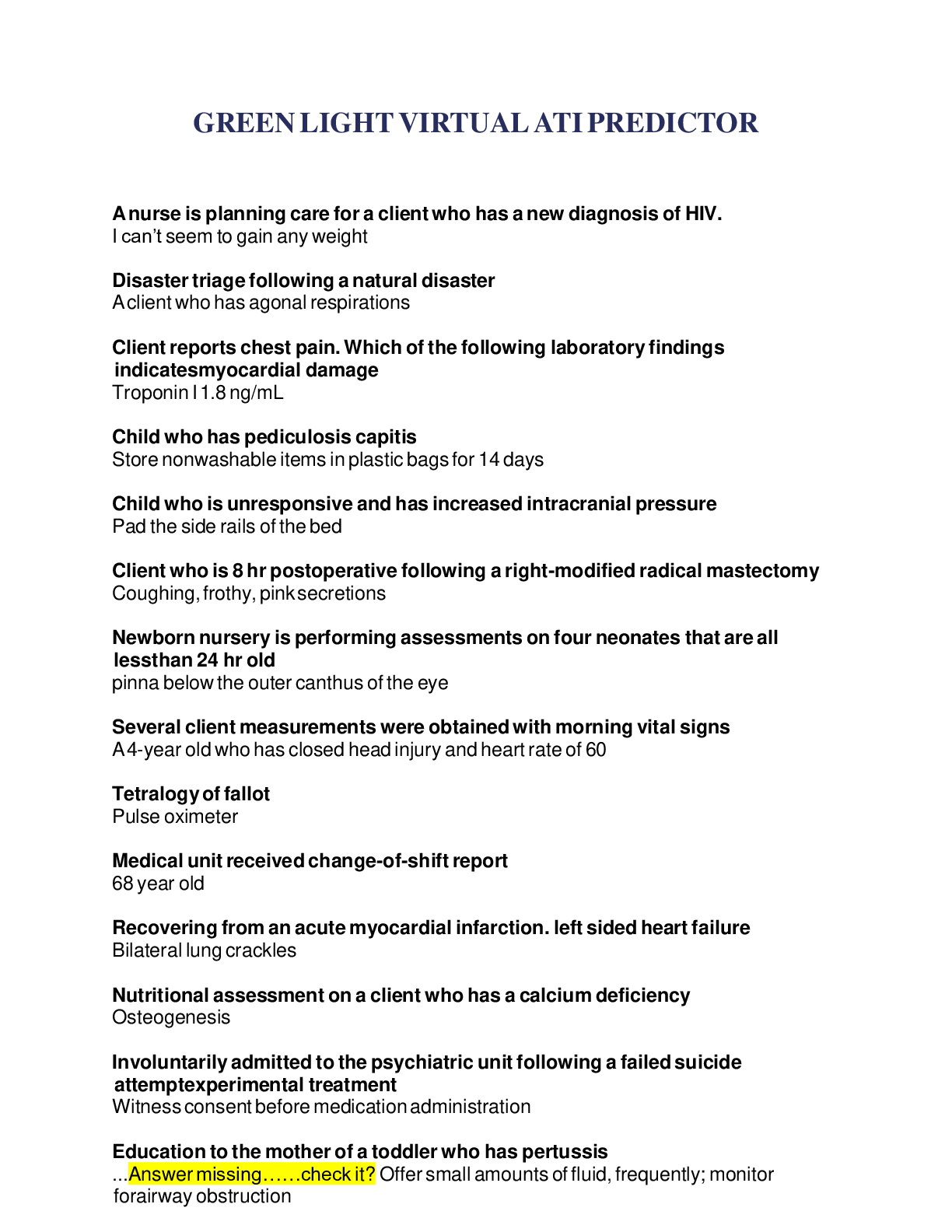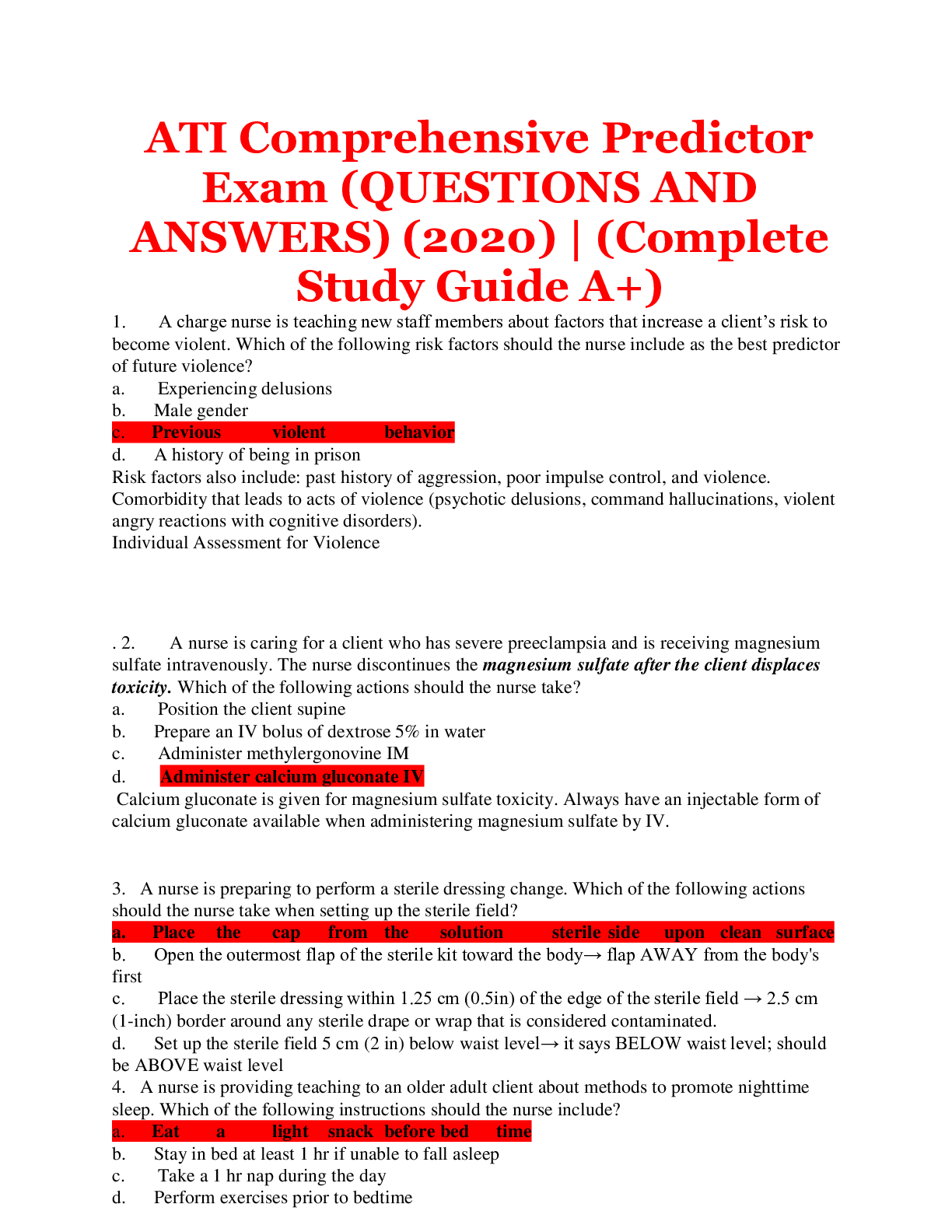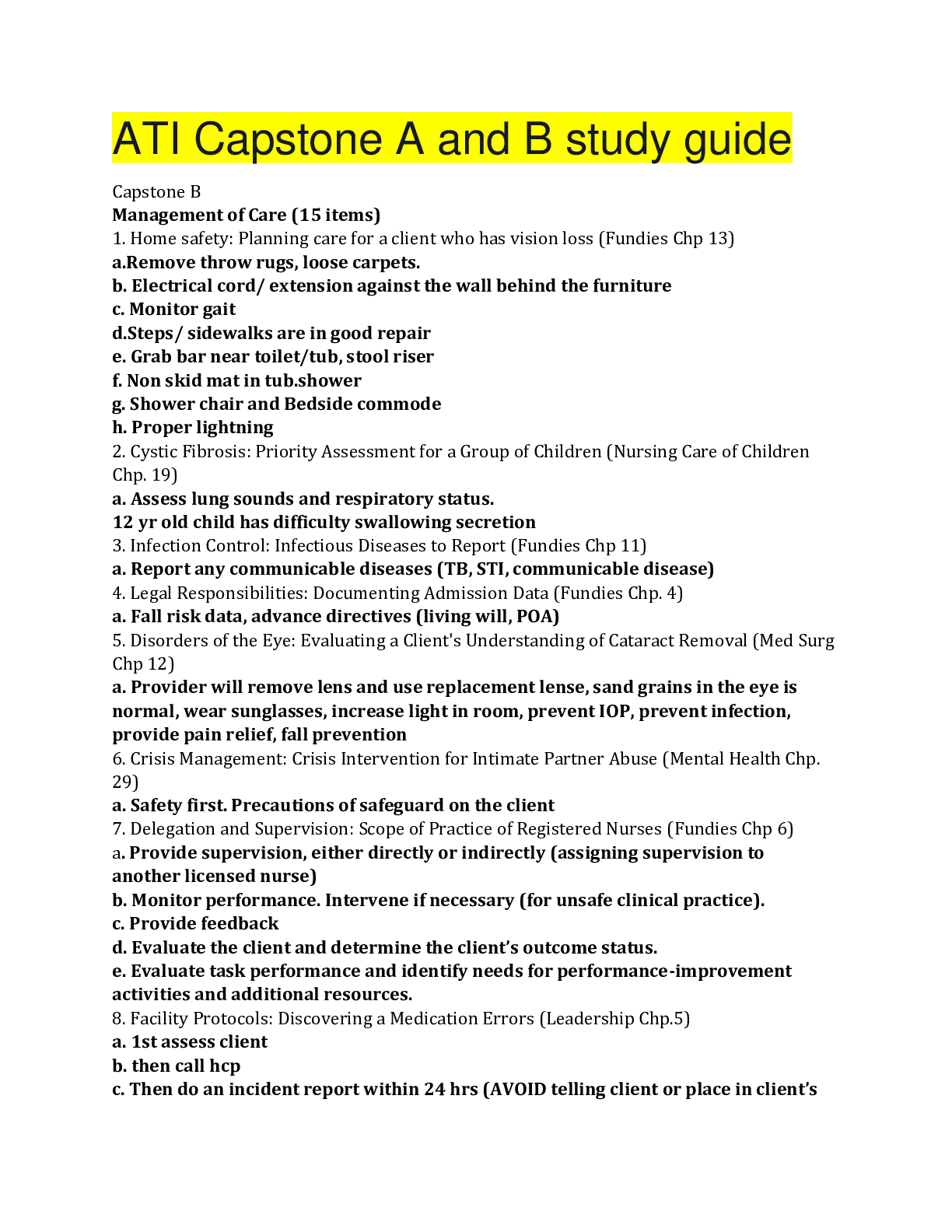*NURSING > QUESTIONS and ANSWERS > ATI Pediatric Practice Exams & Quizzes_2020 | Pediatric Practice Exams & Quizzes_UPDATED (All)
ATI Pediatric Practice Exams & Quizzes_2020 | Pediatric Practice Exams & Quizzes_UPDATED
Document Content and Description Below
Pediatric ATI Practice Exams, quizzes, Finals ❖ Abstraction- abstract thought demonstrated by the ability to draw a conclusion from various pieces of information. ❖ Abuse and neglect- Crosses ... all ethnic backgrounds. Parents might say, “this child is very different from my other children”. This warrants further clarification. A child that has several unexplained scars and bruises, indicates additional assessment is needed. Dark urine indicates a complication from burns. Children will have an underweight appearance, ringed appearing nails. o A nurse in an ED is caring for an adolescent who reports painful urination. Behaviors that suggest possible child maltreatment? Uses mood-elevating substances. A charge nurse in an ED is preparing an in-service for a group of newly licensed nurses on the clinical manifestations of child maltreatment. Which of the following clinical manifestations should the charge nurse include as suggestive of potential physical abuse? Symmetric burns of the lower extremities. A nurse is evaluating a toddler and the family dynamics of the child's family, in which abuse is suspected. What behavior is expected? The child cringes when approached. The child has unexplained healed injuries. The child lies still while surveying the environment. A nurse is admitting a toddler brought to the hospital for circumferential burns. The history given and burn markings do not correlate, therefore, child abuse is suspected. Which of the following should the nurse consider the most important to include in the documentation? A description of the burns. A community health nurse is assessing an 18-month-old toddler in a community day care. Which findings should the nurse identify as a potential indication of physical neglect? Poor personal hygiene. ❖ Acrocyanosis- crying can cause cyanosis in full term babies, appear transient, and have a blue color to hands & feet after birth. ❖ Airway obstruction- to check for obstruction the parent’s should push on the child’s abdomen to assess, listen over the child’s mouth for sounds of breathing, and will use 1 finger to check in the child’s mouth for objects. ❖ Ambiguous genitalia- prepare the child for surgery, obtain a detailed family history, refer the family for genetic counseling, explain the need for a chromosomal analysis. ❖ Anaphylactic reaction- reaction S/S are urticaria, rash, angioedema, and wheezing. A school nurse is assisting a child who has been stung by a bee. The child's hand is swelling and the nurse notes that the child has allergies to insect stings. Which of the following manifestations should the nurse recognize with anaphylaxis? Nausea, urticarial, stridor. A nurse is teaching the parent of an infant about food allergens. Which of the following foods should the nurse include as being the most common food allergy in children? Cow's milk. A nurse is performing an assessment on a child at the clinic. When performing this assessment, the nurse should? have the child sit in the parent's lap, auscultate the heart and lungs, and the examine the ears and throat. ❖ Apgar score- crying vigorously (2), limbs flexed (2), heart rate 120 (2), trunk pink (2), hands and feet are cyanotic (1)= score of 9. ❖ Appendectomy- encourage semi-fowler’s position after procedure. ❖ Appendicitis- A nurse in the ED is caring for an adolescent who has severe abdominal pain due to appendicitis. Which of the following locations should the nurse identify as McBurney's point? (Hotspot) the lower R. quadrant of the abdomen between the umbilicus and the anterior iliac crest. A nurse in an emergency department is caring for a school-age child who has appendicitis and rates his abdominal pain at 7 on a 0 to 10 scale. Which of the following actions should the nurse take? Give morphine 0.05mg/kg IV. A nurse is assessing a school-age child who has appendicitis with possible perforation. The nurse should identify which of the following as a manifestation of peritonitis? abdominal distention. Appendix- when assessing a school-age child immediately postop following a perforated appendix repair Absence of peristalsis, is an expected finding. Semi-fowler’s for appendectomy. ❖ Asthma- risk factors are family history of asthma or allergies, exposure to smoke, and low birth weight. Indications of deterioration are wheezing, retraction of sternal muscles, and nasal flaring. Albuterol is used as needed before exercise and to treat acute asthma attacks. For these children it is important to monitor oxygen saturation, place the child in an upright position, and administer Bronchodilator’s. Peak Flow Meter- zero the meter before each use, perform and document 3 attempts, and use the best attempt as the baseline. o A nurse is auscultating the lungs of an adolescent who has asthma. The nurse should identify the sound as which of the following? Tachypnea. A nurse is providing discharge teaching to the parent of a school-age child who has moderate persistent asthma. Which of the following instructions should the nurse include? "Pulmonary function tests will be performed every 12-24 months to evaluate how your child is responding to therapy." A nurse is providing teaching to the parent of a preschooler about ways to prevent acute asthma attacks. Which of the following statements by the parent should the nurse identify as understanding the teaching? "I should keep my child indoors when I mow the yard.” A nurse is teaching an adolescent who has asthma about how to use a peak expiratory flow meter (PEFM). Which of the following responses by the adolescent indicates an understanding of the teaching? I will record the highest reading of three attempts. A nurse in an emergency department is assessing a school-age child who is experiencing an acute asthma exacerbation. Which of the following findings is the priority for the nurse to report to the provider? Sudden decrease in wheezing. A nurse is caring for a toddler who has asthma. The parents are concerned about the toddler's reaction to the hospitalization. Which of the following nursing actions should the nurse perform to decrease the stress experienced by the toddler? Encourage rooming-in. ❖ Attention deficit hyperactivity disorder (ADHD)- may be caused by prenatal exposure to alcohol, history of head trauma. Child will exhibit inappropriate behaviors. Integrate learning into movement activities, sit the child in front of the room to help focus their attention and reduce the distraction from other activities, provide verbal and written instructions regarding homework assignments, use consistent class rules, schedule exams in a room that provides privacy and minimal stimulation, and give these children regular breaks. ❖ Authoritarian-“My son better do as I say!” ❖ Authoritative- sets rules, and explains the reason behind them, fair parenting. ❖ Autism- if admitted to a hospital, adjust environment by ensuring that staff visits are kept short ❖ Bacterial endocarditis- A nurse is caring for a child with bacterial endocarditis. The child will receive long-term antibiotics and will require a peripherally inserted central catheter. Which of the following statements would be appropriate for the nurse to state to the child’s parent? The PICC line will last several weeks with proper care. ❖ Biliary atresia- yellow sclera, abdominal distention, dark urine. ❖ Bites- prevent insect bites by avoiding areas of tall grass, wear insect repellent, check house pets frequently. ❖ Bone marrow aspiration- A nurse is caring for a child who is undergoing a bone marrow aspiration. Which response indicates to the nurse that the teaching has been effective? I'll have to lie on my belly while it's done. A nurse is teaching a school-age child who is to undergo a bone marrow aspiration. Which of the following statements should the nurse make? I will place a pressure dressing over the areas following the procedure. ❖ Bronchiolitis- administer humidified oxygen, suction the nasopharynx as needed. o A nurse is caring for a child with bronchiolitis. Assessment findings indicate wheezing, oxygen saturation of 100%, respiratory rate of 40/min, and a heart rate of 92/min. The child is receiving oxygen at 2 LPM. An order is written to wean oxygen maintaining oxygen saturation 95% or greater. Which of the following actions is most appropriate for the nurse to take? Lower oxygen to 1 L/min, check the oxygen sat, and reassess the child. ❖ Burns- Antimicrobial ointment is used to prevent infection. Nurse should administer tetanus toxoid if it has been more than 5 years since the prior dose. A clean-dry dressing of fine mesh gauze & a light gauze dressing should be applied that restricts movement to prevent injury to wound. Ice impairs circulation & increase tissue damage. Administer Morphine Sulfate IV via continuous infusion for severe pain. Grafts- infection indicated by unstable body temperatures, subeschar hemorrhage, change in skin color around affected area. o A nurse is creating an educational plan to teach parents about protecting their children from sunburns. Instructions to be included? "Choose a waterproof sunscreen with an SPF of at least 15." A nurse is caring for a preschooler who is scheduled for hydrotherapy treatment for wound debridement following a burn injury. Appropriate action to take prior to the procedure? Administer an analgesic to the child. o 1st degree= Superficial minor burn- damage to epidermis. Appearance is pink to red in color, no blisters, and blanches with pressure. Painful, heals in 3-7 days, no scarring. ▪ A nurse in the emergency department is caring for a school age child who has sustained a superficial minor burn from fireworks on his forearm. which of the following actions should the nurse take? use an antimicrobial ointment on the affected area. o 2nd degree= Superficial partial thickness burn- apply cool, wet compresses to the affected areas. Moderate burns mean initiating a high protein, high calorie diet. Damages the entire epidermis, and not the dermis. Appearance is painful,. Moist, red in color with blisters, mild to moderate edema, and no eschar. Blanches with pressure. Heals in less than 21 days, various scarring, sensitive to temperature changes, exposure to air, and light touch. Minor is less than 10% of TBSA. Moderate is 10%- 20% of TBSA. Severe is greater than 25% of TBSA. Deep partial-thickness burns- damage to the entire epidermis, some parts of the dermis, sweat glands and hair follicles intact. Appearance is mottled, red-white, blisters, moderate edema. Blanches with pressure. Painful, sensitive to temps, and light touch. Healing time can extend beyond 21 days, scarring is likely. ▪ A nurse in the ED is caring for a toddler who has partial-thickness burns on his right arm. Which action should the nurse take? Cleanse the affected area with mild soap and water. A nurse is caring for a child who adheres to a vegetarian diet, and has sustained superficial partial-thickness burns. The nurse would recommend which of the following food choices as having the highest protein content? ½ cup of peanut butter with apple slices. A nurse is caring for a child who has superficial partial-thickness burns over 50% of his body. In planning for the nutritional needs of the child, which of the following should to nurse recognize as an appropriate intervention? Perform dressing changes at least 1 hour before or after meals. A nurse is caring for a 4-year-old child who has superficial partial-thickness burns over 50% of his body. When planning for the nutritional needs of the child, which of the following actions should the nurse plan to take? Supplement feedings with enteral feedings. A nurse is caring for a child who is a vegetarian and has sustained superficial partial-thickness burns on her legs. Which diet choices would be appropriate for this child? Peanut butter and jelly sandwich. Deep partial-thickness burns plan of care is based on concerns related to the child's injury. 1.Impaired gas exchange. 2.Presence of pain. 3.Disturbed fluid balance. 4.Potential for infection. 5.Compromised body image. o 3rd degree= Full thickness- suspect possible septic shock with increased body temperature, altered sensorium, decreased urinary output. Damage to the entire epidermis, dermis, and possible subcutaneous tissue. Appearance is red-tan, black, brown, or waxy white. Dry and leathery. No blanching. As burn heals, painful sensations return and severity of pain increases. Heals within weekly to months. Scarring is present, and grafting is required. Minor can require 1-2 day admission. Moderate is admission to a hospital, preferably a burn clinic. Severe is admission to a burn center. ▪ A nurse is assessing the vital signs of a 10-year-old child following a burn injury. Clinical manifestation indicating early septic shock? Temp 39.1C (102.4F). To evaluate kidney function, the nurse must accurately measure the hourly urine output of a 1½-year-old toddler weighing 22 lb who has been admitted with extensive burns. What is the minimum safe output per hour [Show More]
Last updated: 1 year ago
Preview 1 out of 54 pages
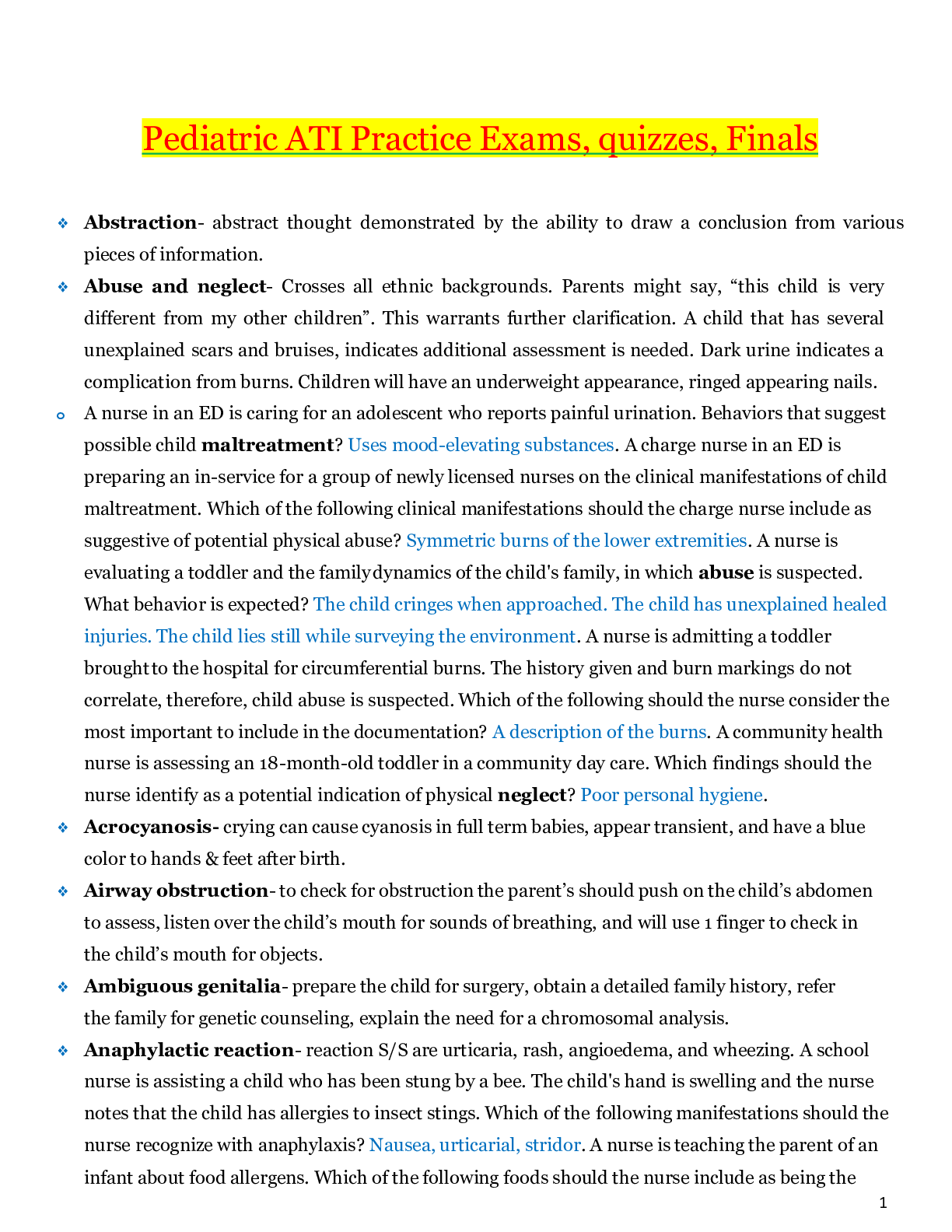
Reviews( 0 )
Document information
Connected school, study & course
About the document
Uploaded On
Apr 04, 2021
Number of pages
54
Written in
Additional information
This document has been written for:
Uploaded
Apr 04, 2021
Downloads
0
Views
26




